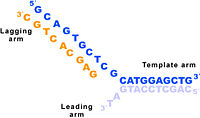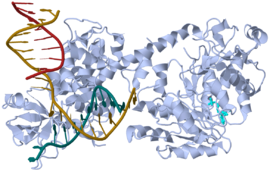RecG Bound to Three-Way DNA Junction
From Proteopedia
Contents |
STRUCTURE OF RECG BOUND TO THREE-WAY DNA JUNCTION
The stalling of DNA replication forks that occurs as a consequence of encountering DNA damage is a critical problem for cells. RecG protein is involved in the processing of stalled replication forks, and acts by reversing the fork past the damage to create a four-way junction that allows template switching and lesion bypass. We have determined the crystal structure of RecG bound to a DNA substrate that mimics a stalled replication fork. The structure not only reveals the elegant mechanism used by the protein to recognize junctions but has also trapped the protein in the initial stage of fork reversal. We propose a mechanism for how forks are processed by RecG to facilitate replication fork restart. In addition, this structure suggests that the mechanism and function of the two largest helicase superfamilies are distinct.
Structural analysis of DNA replication fork reversal by RecG., Singleton MR, Scaife S, Wigley DB, Cell. 2001 Oct 5;107(1):79-89. PMID:11595187
From MEDLINE®/PubMed®, a database of the U.S. National Library of Medicine.
About this Structure
| |||||||||
| 1gm5, resolution 3.24Å (). | |||||||||
|---|---|---|---|---|---|---|---|---|---|
| Ligands: | , | ||||||||
| |||||||||
| |||||||||
| Resources: | FirstGlance, OCA, RCSB, PDBsum | ||||||||
| Coordinates: | save as pdb, mmCIF, xml | ||||||||
1gm5 is a 4 chains structure (1 protein chain and 3 nucleic acid chains) of sequences from Thermotoga maritima. Full crystallographic information is available from OCA.
The is a monomeric protein bound to 3 DNA chains and adenosinediphosphate. [This scene uses the DRuMS color scheme. ]
:
- The N-terminal domain, Domain 1, is about half the protein and extensively contacts the DNA junction.
- Domain 2 is one of the two RecA-like domains common to helicases/translocases; ADP is bound here.
- Domain 3 is the other of the two RecA-like domains common to helicases/translocases.
Schematic of the DNA fork seen in the structure:

:
- N-terminal helical subdomain.
- The wedge subdomain, better shows how this subdomain splits the arms of the junction. Grooves on the sides of the wedge are too narrow to accommodate duplex DNA
- The remainder of domain 1.
:
- The protein is shown in silver to enable highlighting of significant features.
- Phe204 and Tyr208 stack on the orphan bases to stabilize and cap the helical regions at the junction.
- A base that was paired in the original substrate is flipped out in the structure as it seems to be caught in the middle of switching between duplexes of the fork and presumably this base isn't stabilized in keeping with it being a transient state.
. [Note: this view generates a substantial surface which may take several minutes to calculate. Be patient.]
- This scene probably most clearly shows that grooves on the sides of the wedge are too narrow to accommodate duplex DNA.
- Presumably if the template duplex arm were longer as it would be in vivo, it would interact with domains 2 and 3, perhaps in the cleft between them.
Additional Resources
For additional information, see: DNA Replication, Repair, and Recombination
Reference
- Singleton MR, Scaife S, Wigley DB. Structural analysis of DNA replication fork reversal by RecG. Cell. 2001 Oct 5;107(1):79-89. PMID:11595187
Page originally seeded by OCA on Mon Feb 16 22:17:57 2009


